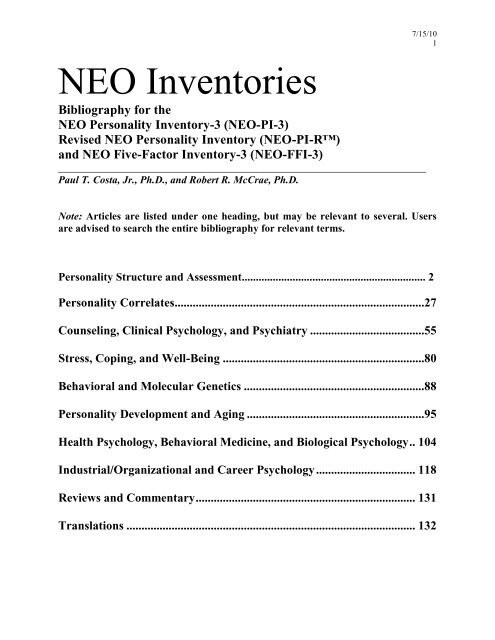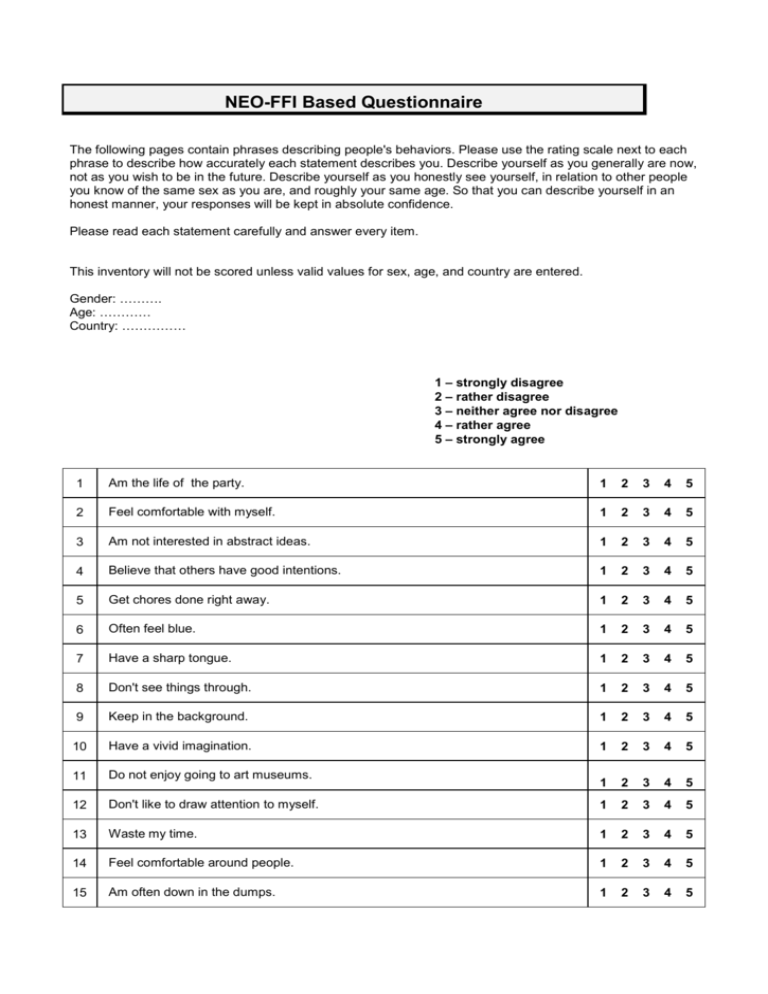
- (PDF) The Revised NEO Personality Inventory (NEO-PI-R)
- Neo Pi-r Questionnaire Free
- NEO PI-3 Business Sample Report


The NEO was originally created as a 3 factor model assessing Neuroticism, Extraversion and Openness. Following the input from many other personality researchers, a revision of the NEO – the NEO-PI-R (that is, “Personality Inventory – Revised”) was published in the late 1980s, around the same time that Lew Goldberg published the Big Five. The IPIP-NEO was written based on the sub-facets proposed by the NEO-PI-R. Developed by Costa and McCrae in 1992, the NEO-PI-R stands for the NEO Personality Index, Revised. As the name suggests, this personality test went through several iterations before arriving to this point. If you are using the hand-scored version of the NEO-PI-R, it is basically self-scoring. You peel back the top sheet to reveal the carbon copy beneath, which displays the points to be added for. Revised NEO PI inventory and irrational procrastination scale were administered on 308 (M = 22.78, SD = 2.86) participants in India. The analysis shows the Mean score of 16.53 (SD,2.37) among Low. Revised NEO personality inventory (NEO PI-R) and NEO five factor inventory. Professional Manual, Psychological Assessment Resources, Odessa, FL (1992) Digman, 1990.

from wikipedia The internal consistency of the NEO scales was assessed on 1,539 individuals (McCrae & Costa,2010). The internal consistency of the NEO PI-R was high, at: N = .92, E = .89, O = .87, A = .86, C = .90. The internal consistency of the facet scales ranged from .56 to .81. The internal consistency of the NEO PI-3 was consistent with that of the NEO PI-R, with α ranging from .89 to .93 for the five domains. Internal consistency coefficient from the facets, with each facet scale comprising fewer items than each of the Big Five scales, were necessarily smaller, ranging from .54 to .83 (McCrae & Costa,2010).
(PDF) The Revised NEO Personality Inventory (NEO-PI-R)
The NEO has been translated into many languages. The internal consistency coefficients of the domain scores of a translation of the NEO that has been used in the Philippines are satisfactory. The alphas for the domain scores range from .78 to .90 (Church & Katigbak, 2002), with facet alphas having a median of .61 (Katigbak et al. 2002). Observer-ratings NEO PI-R data from 49 different cultures was used as criterion in a recent study which tested whether individuals’ perceptions of the “national character” of a culture accurately reflected the personality of the members of that culture (it did not) (Terracciano et al. 2005).
Neo Pi-r Questionnaire Free
The test-retest reliability of the NEO PI-R has also been found to be satisfactory. The test-retest reliability of an early version of the NEO after 3 months was: N = .87, E = .91, O = .86 (McCrae & Costa, 1983). The test-retest reliability for over 6 years, as reported in the NEO PI-R manual, was the following: N = .83, E = .82, O = .83, A = .63, C = .79. Costa and McCrae pointed out that these findings not only demonstrate good reliability of the domain scores, but also their stability (among individuals over the age of 30). Scores measured six years apart varied only marginally more than scores measured a few months apart (Costa & McCrae, 1992).
NEO PI-3 Business Sample Report
The psychometric properties of NEO PI-R scales have been found to generalize across ages, cultures, and methods of measurement(McCrae et al. 2011).